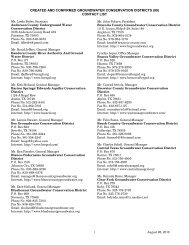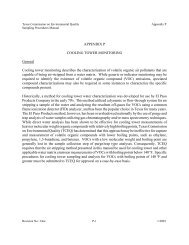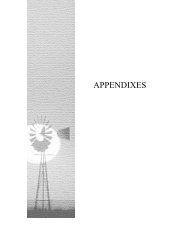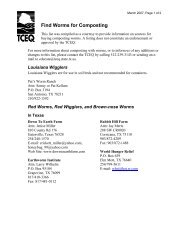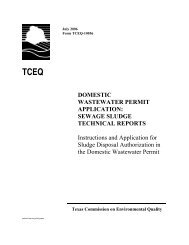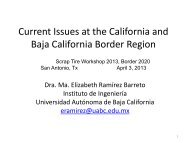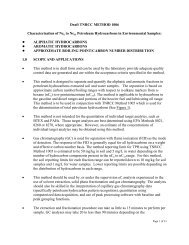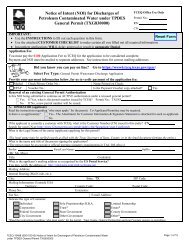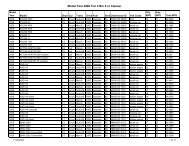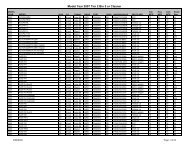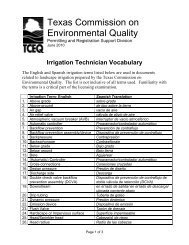joint groundwater report - Texas Commission on Environmental ...
joint groundwater report - Texas Commission on Environmental ...
joint groundwater report - Texas Commission on Environmental ...
Create successful ePaper yourself
Turn your PDF publications into a flip-book with our unique Google optimized e-Paper software.
<str<strong>on</strong>g>groundwater</str<strong>on</strong>g> quality for permit and operati<strong>on</strong>al requirements at approximately 12,400 facilities statewide.Data indicate that an estimated 39,000 m<strong>on</strong>itor and water wells are being used for <str<strong>on</strong>g>groundwater</str<strong>on</strong>g> m<strong>on</strong>itoringpurposes at these facilities. The majority (greater than 99 percent) of the facilities being m<strong>on</strong>itored are underthe jurisdicti<strong>on</strong> of the TNRCC, with the remainder under the jurisdicti<strong>on</strong> of the Railroad <str<strong>on</strong>g>Commissi<strong>on</strong></str<strong>on</strong>g> of<str<strong>on</strong>g>Texas</str<strong>on</strong>g> or the <str<strong>on</strong>g>Texas</str<strong>on</strong>g> Department of Health.The <str<strong>on</strong>g>Texas</str<strong>on</strong>g> Water Development Board and the member districts of the <str<strong>on</strong>g>Texas</str<strong>on</strong>g> Alliance of GroundwaterDistricts c<strong>on</strong>duct <str<strong>on</strong>g>groundwater</str<strong>on</strong>g> m<strong>on</strong>itoring to assess ambient <str<strong>on</strong>g>groundwater</str<strong>on</strong>g> quality c<strong>on</strong>diti<strong>on</strong>s through theassessment of particular c<strong>on</strong>stituents to track changes in water quality over time. M<strong>on</strong>itoring programscarried out by the <str<strong>on</strong>g>Texas</str<strong>on</strong>g> Water Development Board and participating organizati<strong>on</strong>s involved approximately1,000 water wells in 1997. In additi<strong>on</strong>, over 900 water wells were <str<strong>on</strong>g>report</str<strong>on</strong>g>ed as being m<strong>on</strong>itored for ambient<str<strong>on</strong>g>groundwater</str<strong>on</strong>g> quality and changes over time by the member districts of the <str<strong>on</strong>g>Texas</str<strong>on</strong>g> Alliance of GroundwaterDistricts during 1997. Some m<strong>on</strong>itoring programs are developed for water-quality assessment studies whichtarget specific geographic areas, specific c<strong>on</strong>taminants or c<strong>on</strong>stituents, or specific activities. C<strong>on</strong>taminati<strong>on</strong>cases discovered by these agencies or entities through <str<strong>on</strong>g>groundwater</str<strong>on</strong>g> studies or <str<strong>on</strong>g>groundwater</str<strong>on</strong>g> samplingprograms are referred to the regulatory agency with appropriate jurisdicti<strong>on</strong>.The ambient <str<strong>on</strong>g>groundwater</str<strong>on</strong>g> m<strong>on</strong>itoring network has historic limitati<strong>on</strong>s for the parameters which have beenanalyzed. There are very little historical analyses available for c<strong>on</strong>stituents which can generally be attributedto anthropogenic (i.e., man-induced) sources. For example, there are limited analyses available forc<strong>on</strong>stituents such as volatile and synthetic organic compounds and certain heavy metals. Ambient m<strong>on</strong>itoringhas not traditi<strong>on</strong>ally targeted pesticides. At the current time, various sampling projects and studies havebegun to look at potential c<strong>on</strong>taminati<strong>on</strong> of <str<strong>on</strong>g>groundwater</str<strong>on</strong>g> through the normal use of pesticides. Additi<strong>on</strong>alefforts are needed to characterize the potential impact of pesticides <strong>on</strong> <str<strong>on</strong>g>groundwater</str<strong>on</strong>g>.Regulatory <str<strong>on</strong>g>groundwater</str<strong>on</strong>g> m<strong>on</strong>itoring data are extensive in many program areas, however, the applicati<strong>on</strong> ofm<strong>on</strong>itoring requirements within and across regulatory programs can be diverse. This diversity is dependentup<strong>on</strong> the level of program development and the potential of the regulated activity to impact public health.In general, the waste disposal programs, primarily the TNRCC’s Office of Waste Management and the RCT,are doing an effective job of m<strong>on</strong>itoring existing, permitted facilities. Groundwater m<strong>on</strong>itoring requirementshave been established for the petroleum storage tank, industrial and hazardous waste, municipal waste,underground injecti<strong>on</strong> c<strong>on</strong>trol, polluti<strong>on</strong> cleanup (i.e., Superfund), and enforcement for waste programs.Requirements for the municipal solid waste program currently require m<strong>on</strong>itoring at less than 50 percent ofthe facilities within the program. Additi<strong>on</strong>ally, permits required for surface storage and disposal of oil andgas waste and brine retenti<strong>on</strong> ensure the protecti<strong>on</strong> of <str<strong>on</strong>g>groundwater</str<strong>on</strong>g> by requiring liners, leak detecti<strong>on</strong>, and/or<str<strong>on</strong>g>groundwater</str<strong>on</strong>g> m<strong>on</strong>itoring. However, less than two percent of the permanent facilities require <str<strong>on</strong>g>groundwater</str<strong>on</strong>g>m<strong>on</strong>itoring to assure protecti<strong>on</strong> of <str<strong>on</strong>g>groundwater</str<strong>on</strong>g> resources.In the drinking water program, public water supply wells receive sufficient m<strong>on</strong>itoring to ensure violati<strong>on</strong>s ofdrinking water standards are detected and addressed prior to distributi<strong>on</strong>. Currently, there is no state programfor m<strong>on</strong>itoring domestic wells. The <str<strong>on</strong>g>Texas</str<strong>on</strong>g> Department of Licensing and Registrati<strong>on</strong> (TDLR) is resp<strong>on</strong>siblefor m<strong>on</strong>itoring drillers in resp<strong>on</strong>se to complaints and during spot inspecti<strong>on</strong>s, and some domestic wellm<strong>on</strong>itoring may be performed during these site visits.With regard to drinking water programs of the TNRCC, municipal supplies are regulated by the TNRCCClean Water Program within the TNRCC’s Office of Water Resource Management. There are areas wherem<strong>on</strong>itoring for the protecti<strong>on</strong> of <str<strong>on</strong>g>groundwater</str<strong>on</strong>g> could be improved in the wastewater programs. Only 65 out of3,317 private domestic and permitted municipal and industrial wastewater treatment facilities are c<strong>on</strong>ducting4



